Officials from the Chinese Space Agency announced on Friday that they tentatively plan to launch humans into space in October of 2003. China has already launched four prototype Shenzhou spacecraft, with the most recent being a virtual replica of a manned space capsule. According to reports, 14 experienced fighter pilots have been training to become taikonauts for years.
Shuttle Mission Host to Many Scientific Experiments
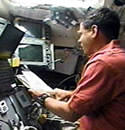
Image credit: NASA
The crew of the space shuttle Columbia have been busy over the last few days as they’ve been completing a series of scientific experiments. Once series of experiments, held in a specially built module, is designed to help scientists understand soot formation, oxidation and radiative properties of flames. There were also a group of biomedical experiments to test the human body’s response to weightlessness.
Columbia’s astronauts studied combustion properties and the response of their own bodies in weightlessness and the behavior of soot in space one-quarter of the way through their marathon scientific research mission.
Red Team members Commander Rick Husband, Mission Specialists Kalpana Chawla and Laurel Clark and Israeli Payload Specialist Ilan Ramon completed the first data collection sessions with the Combustion Module in the Spacehab research module housed in Columbia’s cargo bay. One of three experiments housed in the Combustion Module — the study of Laminar Soot Processes (LSP) — is designed to gain a better understanding of soot formation, oxidation and radiative properties within flames.
Additional data was gleaned from the Mechanics of Granular Materials experiment (MGM) in the Spacehab module, which is providing information on the behavior of saturated sand when exposed to confining pressures in microgravity. The experiment could provide engineers with valuable data for strengthening buildings against earthquakes.
Work was also accomplished with a series of biomedical experiments studying the human body’s response to weightlessness — particularly dealing with protein manufacturing in the absence of a gravity environment, bone and calcium production, the formation of chemicals associated with renal stones and how saliva and urine change in space relative to any exposure to viruses.
Experiments continued with the MEIDEX cameras in the cargo bay observing dust storms in the Mediterranean region and with the SOLSE experiment, geared to studying the amount of ozone in the Earth’s atmosphere by using a special imaging spectrometer in the payload bay to look across the limb of the Earth during specifically scheduled orbits.
Columbia’s Blue Team science cadre — Pilot Willie McCool and Mission Specialists Dave Brown and Mike Anderson — planned to continue the more than 80 experiments on board Columbia following their wakeup call this afternoon. The Red team will begin its eight-hour sleep period just before 9 p.m. Central time.
Earlier today, TV cameras in the Spacehab research module captured Ramon conducting work with the Combustion Module. He reported that the materials science facility was operating perfectly as are all of the other experiment facilities aboard Columbia.
Aboard the International Space Station, Commander Ken Bowersox, Flight Engineer Nikolai Budarin and ISS Science Officer Don Pettit completed their second month in space by enjoying an off-duty day. The crew will return to a full complement of scientific research activities, exercise and routine ISS maintenance work on Monday. The ISS crew is working a schedule, which calls for them to be awakened every morning at 12:00 a.m. Central time and for their 8 ? hour sleep period to begin at 3:30 p.m. CST.
The ISS crew was informed that replacement parts for the Microgravity Science Glovebox will be ready for launch on the next Progress resupply vehicle to the ISS on February 2. With docking of that cargo ship to the ISS planned for Feb. 4, virtually all of the science planned for the facility during Expedition 6 will be accomplished as initially planned.
Original Source: NASA News Release
I Want My NASA TV!
If you’re a Canadian? read this! If you’re not a Canadian, well, still read it… you can help us out. 🙂
I was visiting my Father about 5 years ago, and we were sitting in the kitchen when he said, “hey, it’s time to watch the floaters.” Wha? He turned on the kitchen television, and there was a live broadcast of some astronauts spacewalking outside the shuttle. I couldn’t believe my eyes.
Apparently, my clever Dad had jury-rigged an old satellite dish so that it would receive a television feed from NASA. NASA has a television channel, and it’s all about their space exploration. It could be the greatest thing ever. Okay, it gets a little boring between space launches, but overall, it’s a tremendous channel to have access to.
My Father, on remote Hornby Island, gets NASA television loud and clear. But there’s no way I can get it here in Vancouver. I called my cable company… nope. Then I got a digital satellite dish… nope, sorry.
The only place I can watch NASA TV is on my computer. Ever watched television on your computer? It’s small, blurry, choppy and cuts off all the time. Anyway, I stare enough at computer monitors.
I want my NASA TV.
Well much to my surprise, the Canadian Canadian Radio and Television Commission was actually in discussions to get the cable companies to offer it, but it all fell apart. We get Jerry Springer, but we can’t watch NASA TV. Fortunately, we do get the Daily Show with Jon Stewart, which is about the only thing that gets me to turn my television on these days.
Now there’s hope. The Friends of NASA TV in Canada. It’s a petition to try to convince the CRTC and cable companies to get us the space news we so richly deserve.
If you’re a Canadian, visit their website and sign the petition. Not only that, I want you find as many other Canadians who will do what you say, and get them to sign this. Do it!
If you’re not a Canadian, but you know a Canadian, I want you to send them an email begging them to sign this petition. You got it? Good.
I want my NASA TV.
Fraser Cain, Publisher
Universe Today
New Study of Virgo Galaxy Cluster
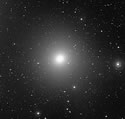
Image credit: ESO
New observations from the Japanese 8-m Subaru telescope and the ESO Very Large Telescope (VLT) have revealed new details in the Virgo galaxy cluster – located 50 million light years away. One insight is that massive young stars seem to be able to form in isolation, far away from the brighter parts of galaxies.
At a distance of some 50 million light-years, the Virgo Cluster is the nearest galaxy cluster. It is located in the zodiacal constellation of the same name (The Virgin) and is a large and dense assembly of hundreds of galaxies.
The “intracluster” space between the Virgo galaxies is permeated by hot X-ray emitting gas and, as has become clear recently, by a sparse “intracluster population of stars”.
So far, stars have been observed to form in the luminous parts of galaxies. The most massive young stars are often visible indirectly by the strong emission from surrounding cocoons of hot gas, which is heated by the intense radiation from the embedded stars. These “HII regions” (pronounced “Eitch-Two” and so named because of their content of ionized hydrogen) may be very bright and they often trace the beautiful spiral arms seen in disk galaxies like our own Milky Way.
New observations by the Japanese 8-m Subaru telescope and the ESO Very Large Telescope (VLT) have now shown that massive stars can also form in isolation, far from the luminous parts of galaxies. During a most productive co-operation between astronomers working at these two world-class telescopes, a compact HII region has been discovered at the very boundary between the outer halo of a Virgo cluster galaxy and Virgo intracluster space.
This cloud is illuminated and heated by a few hot and massive young stars. The estimated total mass of the stars in the cloud is only a few hundred times that of the Sun.
Such an object is rare at the present epoch. However, there may have been more in the past, at which time they were perhaps responsible for the formation of a fraction of the intracluster stellar population in clusters of galaxies. Massive stars in such isolated HII regions will explode as supernovae at the end of their short lives, and enrich the intracluster medium with heavy elements.
Observations of two other Virgo cluster galaxies, Messier 86 and Messier 84, indicate the presence of other isolated HII regions, thus suggesting that isolated star formation may occur more generally in galaxies. If so, this process may provide a natural explanation to the current riddle why some young stars are found high up in the halo of our own Milky Way galaxy, far from the star-forming clouds in the main plane.
The Virgo Cluster
The galaxies in the Universe are rarely isolated – they prefer company. Many are found within dense structures, referred to as galaxy clusters, cf. e.g., ESO PR Photo 16a/99.
The galaxy cluster nearest to us is seen in the direction of the zodiacal constellation Virgo (The Virgin), at a distance of approximately 50 million light-years. PR Photo 04a/03 (from the Wide Field Imager camera at the ESO La Silla Observatory) shows a small sky region near the centre of this cluster with some of the brighter cluster galaxies. PR Photo 04b/03 displays an image of a larger field (partially overlapping Photo 04a/03) in the light of ionized hydrogen – it was obtained by the Japanese 8.2-m Subaru telescope on Mauna Kea (Hawaii, USA). The field includes some of the large galaxies in this cluster, e.g., Messier 86, Messier 84 and NGC 4388. In order to show the faintest possible hydrogen emitting objects embedded in the outskirts of bright galaxies, their smooth envelopes have been “subtracted” during the image processing. This is why they look quite different in the two photos.
Clusters of galaxies are believed to have formed because of the strong gravitational pull from dark and luminous matter. The Virgo cluster is considered to be a relatively young cluster, because studies of the distribution of its member galaxies and X-ray investigations of hot cluster gas have revealed small “subclusters of galaxies” around the major galaxies Messier 87, Messier 86 and Messier 49. These subclusters are yet to merge to form a dense and smooth galaxy cluster.
The Virgo cluster is apparently cigar-shaped, with its longest dimension of about 10 million light-years near the line-of-sight direction – we see it “from the end”.
Stars in intracluster space
Galaxy clusters are dominated by dark matter. The largest fraction of the luminous (i.e. “visible”) cluster mass is made up of the hot gas that permeates all of the cluster. Recent observations of “intracluster” stars have confirmed that, in addition to the individual galaxies, the Virgo cluster also contains a so-called “diffuse stellar component”, which is located in the space between the cluster galaxies.
The first hint of this dates back to 1951 when Swiss astronomer Fritz Zwicky (1898-1974), working at the 5-m telescope at Mount Palomar in California (USA), claimed the discovery of diffuse light coming from the space between the galaxies in another large cluster of galaxies, the Coma cluster. The brightness of this intracluster light is 100 times fainter than the average night-sky brightness on the ground (mostly caused by the glow of atoms in the upper terrestrial atmosphere) and its measurement is difficult even with present technology. We now know that this intracluster glow comes from individual stars in that region.
Planetary nebulae
More recently, astronomers have undertaken a new and different approach to detect the elusive intracluster stars. They now search for Sun-like stars in their final dying phase during which they eject their outer layers into surrounding space. At the same time they unveil their small and hot stellar core which appears as a “white dwarf star”.
Such objects are known as “planetary nebulae” because some of those nearby, e.g. the “Dumbbell Nebula” (cf. ESO PR Photo 38a/98) resemble the disks of the outer solar system planets when viewed in small telescopes.
The ejected envelope is illuminated and heated by the very hot star at its centre. This nebula emits strongly in characteristic emission lines of oxygen (green; at wavelengths 495.9 and 500.7 nm) and hydrogen (red; the H-alpha line at 656.2 nm). Planetary nebulae may be distinguished from other emission nebulae by the fact that their main green oxygen line at 500.7 nm is normally about 3 to 5 times brighter than the red H-alpha line.
Search for intracluster planetary nebulae
An international team of astronomers [2] is now carrying out a very challenging research programme, aimed at finding intracluster planetary nebulae. For this, they observe the regions between cluster galaxies with specially designed, narrow-band optical filters tuned to the wavelength of the green oxygen lines.
The main goal is to study the overall properties of the diffuse stellar component in the nearby Virgo cluster. How much diffuse light comes from the intracluster space, how is it distributed within the cluster, and what is its origin?
Because the stars in this region are apparently predominantly old, the most likely explanation of their presence in this region is that they formed inside individual galaxies, which were subsequently stripped of many of their stars during close encounters with other galaxies during the initial stages of cluster formation. These “lost” stars were then dispersed into intracluster space where we now find them.
The Subaru observations
Japanese and European astronomers used the Suprime-Cam wide-field mosaic camera at the 8-m Subaru telescope (Mauna Kea, Hawaii, USA) to search for intracluster planetary nebulae in one of the densest regions of the Virgo cluster, cf. PR Photo 04b/03. They needed a telescope of this large size in order to select such objects and securely discriminate them from the thousands of foreground stars in the Milky Way and background galaxies.
In particular, by observing in two narrow-band filters sensitive to oxygen and hydrogen, respectively, the planetary nebulae visible in this field could be “separated” from distant (high-redshift) background galaxies, which do not have strong emission in both the green and red band. It is very time-consuming to observe the weak H-alpha emission and this can only be done with a big telescope.
Some 40 intracluster planetary nebulae candidates were found in this field which had the expected oxygen/H-alpha line intensity ratios of 3 – 5, such as those depicted PR Photo 04d/03. Unexpectedly, however, the data also showed a small number of star-like emission objects with oxygen/H-alpha line ratios of about 1. This is more typical of a cloud of ionized gas around young, massive stars – like the so-called HII regions in our own galaxy, the Milky Way.
However, it would be very unusual to find such star formation regions in the intracluster region, so follow-up spectroscopic observations were clearly needed for confirmation.
The VLT measurements
The only way to make sure that these unusual objects are actually powered by young stars is by a detailed spectroscopical study, analyzing the emitted light over a wide range of wavelengths. One of the objects was observed in this way in April 2002 with the FORS2 multi-mode instrument at the 8.2-m VLT YEPUN telescope at the ESO Paranal Observatory (Chile).
This was a most challenging observation, even for this very powerful facility, requiring several hours of exposure time. The brightness of the faint object (the flux of the oxygen [OIII 500.7]-line) was comparable to that of a 60-Watt light bulb at a distance of about 6.6 million km, i.e., about 17 times farther than the Moon.
The recorded (long-slit) spectrum (PR Photo 04e/03) is indeed that of an HII region, with characteristic emission lines from hydrogen, oxygen and sulphur, and with underlying blue “continuum” emission from hot, young stars. This is the first concrete evidence that some of the ionized hydrogen gas in the intracluster medium near NGC 4388 is heated by massive stars, rather than radiation from the nucleus of the galaxy.
Comparing the spectrum with simple starburst models showed that this HII region is “powered” by one or two hot and massive (O-type) stars. The best-fitting starburst model implies an estimated total mass of young stars of some 400 solar masses with an age of about 3 million years. The object is obviously very compact – it is indeed unresolved in all the images. The inferred radius of the HII region is about 11 light-years.
Young stars form far from galaxies
This compact star-forming region is located about 3.4 arcmin north and 0.9 arcmin west of the galaxy NGC 4388, corresponding to a distance of some 82,000 light-years (projected) from the main star-forming regions in this galaxy. The small cloud is moving away from us with an observed velocity of 2670 km/sec. This is considerably faster than the mean velocity of the Virgo cluster (about 1200 km/sec) but similar to that of NGC 4388 (2520 km/sec), indicating that it is probably falling through the Virgo cluster core together with NGC 4388, but it cannot have moved far during the comparatively short lifetime of its massive stars.
It is not known whether it once was or still is bound to NGC 4388, or whether it only belonged to the surroundings that fell into the Virgo cluster with this galaxy. In any case, the existence of this HII region is a clear demonstration that stars can form in the “diffuse” outskirts of galaxies, if not in intracluster space.
Because of internal dynamical processes, the stars in this object cannot remain forever in a dense cluster. Within a few hundred million years they will disperse and mix with the diffuse stellar population nearby. This isolated star formation is therefore likely to contribute to the intracluster stellar population, either directly, or after having moved away from the halo of NGC 4388.
This mode of isolated star formation does not contribute much to the total intracluster light emission – at the current rate it can explain only a small fraction of the diffuse light now observed in this region. However, it may have been more significant in the past, when protogalaxies and proto-galaxy groups, rich in neutral gas and with gas clouds at large distances from their centers, fell into the forming Virgo cluster for the first time.
Prospects
The existence of isolated compact HII regions like this one is important as a very different site of star formation than those normally seen in galaxies. The massive stars born in such isolated clouds will explode as supernovae and enrich the Virgo intracluster medium with metals.
Other possible – but not yet spectroscopically verified – compact HII regions in the halos of both Messier 86 and Messier 84 have been detected during this work. This finding thus also calls into question the current use of emission-line planetary nebulae luminosities as a distance indicator; to obtain the best possible accuracy, it will henceforth be necessary to weed out possible HII regions in the samples.
If compact HII regions exist generally in galaxies, they may possibly be the birthplaces of some of the young stars now observed in the halo of our Milky Way galaxy, high above the main plane. Observational programmes with both the Subaru and VLT telescopes are now planned to discover more of these interesting objects and to explore their properties.
Original Source: ESO News Release
Hubble Offers a Clear View of a Quasar
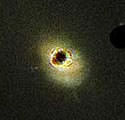
Image credit: Hubble
The Hubble Space Telescope has provided the clearest view of nearby Quasar 3C 273 ever taken in visible light. The image was taken by using the newly installed Advanced Camera for Surveys (ACS), which is able to block the brightest light to show the dimmer parts of the object. Features in the galaxy surrounding the central quasar are clearly visible.
NASA Hubble Space Telescope’s new Advanced Camera for Surveys (ACS) has provided the clearest visible-light view yet of the nearby quasar 3C 273. The ACS’ coronagraph was used to block the light from the brilliant central quasar, revealing that the quasar’s host galaxy is significantly more complex than had been suggested in previous observations. Features in the surrounding galaxy normally drowned out by the quasar’s glow now show up clearly. The ACS reveals a spiral plume wound around the quasar, a red dust lane, and a blue arc and clump in the path of the jet blasted from the quasar. These details had never been seen before. Previously known clumps of hot gas and the inner blue optical jet are now resolved more clearly.
The power of the ACS coronagraph is demonstrated in this picture. The Hubble image on the left, taken with the Wide Field Planetary Camera 2, shows the brilliant quasar but little else. The diffraction spikes demonstrate the quasar is truly a point-source of light (like a star) because the black hole’s “central engine” is so compact. Once the blinding “headlight beam” of the quasar is blocked by the ACS (right), the host galaxy pops into view. Note that the ACS’ occulting “finger” and other coronagraphic spot are seen in black near the top of the ACS High Resolution Channel image.
Quasars (also known as QSOs ? short for quasi-stellar objects) were discovered in the early 1960s, but at least two decades passed before astronomers had observational evidence that they reside in galaxies. They now are commonly accepted to be supermassive black holes accreting infalling gas and dust. Using the ACS, astronomers want to learn what activities in a quasar’s host galaxy feed the black hole, allowing it to “turn on” as a quasar.
Original Source: Hubble News Release
Rosetta Will Have to Be Dismantled
Now that Rosetta has been delayed indefinitely from its original mission to visit Comet Wirtanen, technicians have to dismantle the spacecraft and return each scientific instrument to the researchers who built them. The mission was cancelled because a recent report indicated that the Ariane 5 rocket was unsafe to launch. Rosetta’s original target was Comet Schwassmann-Wachmann 3, then Comet Wirtanen, so now planners are considering Comets Finlay, Brooks 2 and Wild 2. There’s no scheduled launch date, though.
Columbia Launches on Science Mission
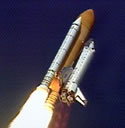
Image credit: NASA
The Space Shuttle Columbia lifted off from Cape Canaveral yesterday, carrying the first Israeli astronaut and six crewmates on a scientific mission. Columbia blasted off at 1539 GMT (10:39 am EST) and reached orbit 9 minutes later. The astronauts have a total of 80 experiments to perform over the next 16 days.
Columbia lifted off from the Kennedy Space Center this morning on the first shuttle mission of the year, carrying the first Israeli astronaut into orbit along with six crewmates on a marathon international scientific research flight.
Commander Rick Husband, Pilot Willie McCool, Mission Specialists Dave Brown, Kalpana Chawla and Laurel Clark, Payload Commander Mike Anderson and Payload Specialist Ilan Ramon of the Israel Space Agency blasted off at 9:39 a.m. CST from Launch Pad 39-A. Less than nine minutes later, Columbia settled into an orbit inclined 39 degrees to the equator.
The seven astronauts will divide their duties into two teams working 12-hour shifts to conduct round-the-clock science. Aboard Columbia more than 80 experiments dealing with astronaut health and safety, advanced tehnology development and Earth and space sciences.
Husband, Chawla, Clark and Ramon comprise the Red team which will work in the pre-dawn and daytime hours, while McCool, Brown and Anderson make up the Blue team, working the evening and overnight hours.
Once in orbit, the crewmembers will begin to unstow gear and prepared for the opening of Columbia’s payload bay doors, before activating hardware and experiments in a double Spacehab research module housed in the shuttle’s cargo bay, which contains the lion’s share of the mission’s science. Other experiments housed in the cargo bay also will be activated, along with a special pallet of cryogenic fuel tanks at the rear of the cargo bay which will provide Columbia and its experiments sufficient electrical power for the duration of the flight.
Having shifted their sleep schedule to accommodate the dual-shift operations, McCool, Brown and Anderson will begin an abbreviated six-hour sleep period at 1:39 p.m. CST and will be awakened at 7:39 p.m. while Red team counterparts continue the early stages of experiment activation. Husband, Chawla, Clark and Ramon will begin an eight-hour sleep period at 8:39 p.m. and will be awakened Friday at 4:39 a.m. to handover work from the Blue team which will be continuing the initial phase of scientific studies overnight.
As Columbia was launched, the Expedition 6 crew aboard the International Space Station was orbiting over the northern Pacific Ocean south of the Aleutian island chain. Commander Ken Bowersox, Flight Engineer Nikolai Budarin and NASA ISS Science Officer Don Pettit are in their 54th day in space, their 52nd day on board the station.
The next STS-107 mission status report will be issued this evening, or earlier if events warrant.
Original Source: NASA News Release
NASA Announces Shuttle Launch Time
NASA announced the official launch time of the Space Shuttle Columbia on Wednesday, as part of its new policy of keeping the time secret until 24 hours before launch. If all goes well, the shuttle will lift off from Florida’s Cape Canaveral at 1539 GMT (10:39 am EST). The shuttle won’t dock with the International Space Station this mission, so there is a long launch window of 2.5 hours. The weather looks excellent for launch.
QuikScat Captures Images of Melting Ice Shelf
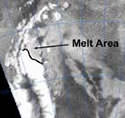
Image credit: NASA
An instrument on board NASA’s Quick Scatterometer spacecraft has detected the earliest melting in Antarctica’s Larsen Ice Shelf. This huge plate of glacier-fed ice has been disintegrating since 1995, losing nearly 10-percent of its size (more than two trillion tonnes of ice), and the most recent chunk disappeared due to a cyclone that sent warm weather into the area.
An international research team using data from NASA’s SeaWinds instrument aboard the Quick Scatterometer spacecraft has detected the earliest yet recorded pre-summer melting event in a section of Antarctica’s Larsen Ice Shelf. This huge, nearly 200 meter (656 foot) thick plate of glacier-fed floating ice, which in the late 1980s was about as large as Indiana, experienced dramatic disintegration events beginning in 1995 that have reduced its area by nearly 10 percent, or more than two trillion tons of ice.
Researchers Dr. Mark Drinkwater of the European Space Agency, Dr. David Long of Brigham Young University and Dr. Steve Harangozo of the British Antarctic Survey used near real time Quick Scatterometer (QuikScat) data to document a rapid, extensive melting of the Larsen C Ice Shelf in Antarctica’s Weddell Sea from Oct. 27 to Oct. 29, 2002. The melting, which extended to 68 degrees south, was triggered by a mid-latitude cyclone that delivered warm air to the region. The same storm is believed to have also caused a noticeable recession in the sea-ice margin to the west of the Antarctic Peninsula. The QuikScat images are available at: http://photojournal.jpl.nasa.gov/catalog/PIA03894
Air temperatures in the region typically exceed freezing for a few days on or after November 1 each year-a precursor to sustained summer melting that normally sets in several weeks later at these latitudes. The cumulative duration of these annual summer melting events is likely to have increased substantially over the past 50 years as summer average air temperatures on the eastern side of the Antarctic Peninsula have warmed appreciably (approximately two degrees Celsius, or 3.6 degrees Fahrenheit). Scientists believe these events are responsible for the previous breakups of Larsen and other ice shelves. Therefore, the ability to observe such events in near real time using scatterometers is of great interest to researchers, since they may provide invaluable clues to the fate of other, much larger Antarctic ice shelves.
While scientists used to believe there was no connection between recent Antarctic Peninsula warming and the natural cycle of deglaciation, recent field measurements provide some evidence to suggest the frequency of summer melting, and the resulting quantities of melt water penetrating ice shelves, may be connected with the accelerated disintegration of Larsen and other Antarctic ice shelves.
“The water is believed to penetrate cracks and fissures in the ice and refreeze at depth, where the ice is relatively colder,” said Drinkwater. “As the ice expands, this process effectively drives a wedge into existing cracks to accelerate the natural fracture process.”
Scatterometers operate by transmitting high-frequency microwave pulses to Earth’s surface and measuring the “backscattered,” or echoed, radar pulses bounced back to the satellite. Moshe Pniel, scatterometer projects manager at NASA’s Jet Propulsion Laboratory, Pasadena, Calif., which developed and manages the instruments, said scatterometers such as SeaWinds on QuikScat and a similar SeaWinds instrument on Japan’s recently launched Advanced Earth Observing Satellite 2 (Adeos 2), are proving to be increasingly important in monitoring land and ice processes.
“Scatterometers can effectively and quickly detect the difference between melting and dry surfaces,” he said. “They provide an important new tool in our capability to monitor climate change impacts on the Antarctic ice cover on a daily basis. These scatterometer data are vital in the southern hemisphere because near real time synthetic aperture radar data is not available there on a frequent, uninterrupted basis. QuikScat measurements being compiled and archived in the Scatterometer Climate Record Pathfinder study by Long and Drinkwater (http://www.scp.byu.edu) enable critical assessments of the links between changes taking place in global ice cover and associated changes in important elements of Earth’s closely-linked ocean-atmosphere climate system.”
QuikScat measurements and image data developed by Long are processed and distributed in near real time by the National Oceanic and Atmospheric Administration, providing scientists at the British Antarctic Survey and elsewhere with rapid access to low-resolution radar data that can be used to report melt events. The British Antarctic Survey compiles and distributes Antarctic Meteorological Station data in near real time.
More information about SeaWinds is available at: http://winds.jpl.nasa.gov/index.html.
NASA’s Earth Science Enterprise is a long-term research effort to understand and protect our home planet. The California Institute of Technology in Pasadena manages JPL for NASA.
Original Source: NASA/JPL News Release
Where Should the Next Martian Rovers Land?
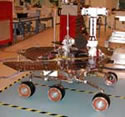
Image credit: NASA
With only a few months to go before NASA launches its next two rovers to Mars, mission planners need to pin down exactly where they want the robot explorers to touch down. The twin Mars Exploration Rovers are scheduled for launch in May and June of 2003, and they currently have four candidate landing locations picked out – each of which offers unique terrain to explore. The final decision will be made in April.
The launch dates for the two Mars Exploration Rovers are getting closer and so is the need to pick a place for them to land.
Adventurous travelers might spin a globe and pick a vacation based on whichever spot their finger finds. But scientists and engineers working on NASA’s newest rover mission cannot be as casual about landing site choices for the twin rovers that will launch in May and June of this year.
Last week, team members and others from the scientific community met for a final chance to discuss and fine-tune the pros and cons of each of the four landing site contenders.
Images and data from two other NASA spacecraft currently orbiting the red planet — Mars Global Surveyor and Mars Odyssey — have provided invaluable information on possible landing sites.
“This is a unique period where we have orbital missions that can help us make the selection,” said Dr. Matt Golombek, JPL landing site scientist. “We want to go to sites with terrains that will challenge our minds but not the safety of the rovers.”
Since the rovers do not have the luxury of landing on a well-paved runway, JPL geologists and engineers must carefully choose an area without large rocks that could damage the rovers’ airbag landing system. Also, an area that is too densely populated with rocks of any size could prevent the rover from moving freely. Winds in the lower atmosphere are also an important consideration, as are the slopes the airbag-clad lander impact against.
Adequate exposure to the sun is vital for the solar-powered rovers. Geologists have chosen sites near the equator where there is sufficient sunlight. The sites are also relatively free of accumulations of iron-oxide dust particles that can coat solar panels and interfere with the rovers’ mobility.
Like the final four in any competition, each of the four Mars candidates is a potential winner.
“Three of the sites, Terra Meridiani, known as the Hematite site, Gusev, and Isidis show evidence for surface processes involving water. These sites appear capable of addressing the science objectives of the rover missions: to determine if water was present on Mars and whether there are conditions favorable to the preservation of evidence for ancient life,” said Golombek.
The fourth site, Elysium, appears to contain ancient terrain, which may hold clues to Mars’ early climate when conditions may have been wetter.
Over the next several months, geologists and engineers will continue to analyze the viability of each site. The final decision will be made by NASA in April, shortly before the rovers begin their journey to Mars.
Original Source: NASA/JPL News Release
